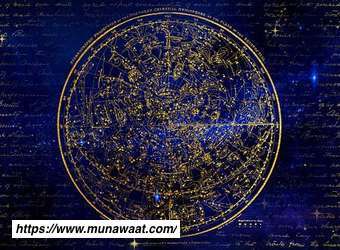Horoscope
Astronomical constellations are the divisions of the zodiac or the suns path with twelve celestial divisions. What distinguishes them from the constellations is that they are divided into a map of the sky with all its masses, which are groups of stars visible to the naked eye. The constellations are the division of the circle in which the sun, moon, and the eight planets pass.
There are 12 constellations in the zodiac, and they cover a portion of them. The constellations also bear the names of animals, objects, religious and mythological figures. Each of them has 30 degrees of arc on the suns path, and the latter passes one sign in a solar month; the solar months are called in the heliometric calendar in this twelve zodiac.
Later, Babylonian astrology was influenced by Hellenistic culture. According to astrology, celestial phenomena are associated with human activity, so signs are considered to express distinct patterns of expression.
Recent discoveries about the true nature of celestial masses have undermined the theoretical basis for astrological signs and experimental. Scientific research has shown that predictions and recommendations based on these constellations are not accurate. Astrology is generally considered a pseudoscience.
Constellations
There are twelve signs that astrologers use.
- Aries
- Bull
- Gemini
- cancer
- Leo
- Virgin
- Balance
- Scorpion
- Sagittarius
- Capricorn
- Aquarius
- Pisces
The history of the zodiac
Babylonian, Greek, and ancient Egyptian influences
Although Europe took astrological signs from the Greeks and Romans, its origins date back to the era of Babylon. Some ancient manuscripts refer to the signs of the Sumerian constellations, so we cannot say that the constellations` origin is Sumerian. The division of the circle of heaven into 12 equal parts goes back to Babylonian manuscripts
By the fourth century BC, the science of the Babylonian star was influencing Greek culture. By the second century BC, the ancient Egyptians had mixed astrology with Babylonian astrology. According to Babylonian culture, a link was established between the star systems, the celestial planets, the date of human birth, and astrology was invented using straight insight (the degree of the height of the heavenly circle at the time of birth.) and its relationship to the twelve constellations. There was also a link between astrological signs; Greek philosophy claimed that the universe consists of four elements (water, air, fire, and earth). Therefore, symbols known to this day for astrological signs were introduced.
Astrological signs in modern science
In science, astrology and beliefs of the zodiac are pseudoscience's. The constellations failed to obtain any scientific evidence; it has been proven that the predictability through signs does not exceed the expectations of chance, as in the research of twins conducted by researchers from George August University on 234 twins. One would expect this if one expected something random in terms of the percentage of correct expectations.
Furer and Berstein created two similar tests, the first related to the zodiac, if he wrote certain random predictions and presented them to his students for many years, and asked them to match them with their personality on a scale of 0 to 5, so the rate he got from his summary of his experiences was 4.2, and thus the effect became known as the effect. Looking to match people with what is expected of them, whether in horoscopes, psychoanalysis, or other things. As for Burstein, he created a general scale to test the validity of any methods, which claims the ability to analyze characters or predict the future and astrology, has failed to succeed on this scale.
Belief in astrology is very harmful, as Japan recorded a 25% drop in births and abortions of 500,000 newborns in a year that astrologers expected to be a bad year for women, specifically 1966 in what is known in the Japanese zodiac as the year of the fire horse. This is if we exclude the damage to relationships, work, and personal decisions that occur in different parts of the world due to people's beliefs in the horoscopes and their fear or determination to do certain things based on those beliefs. It should be noted that there are major errors in the currently approved astrological calculations in the constellations, for example, that a person's horoscope changes every 18 years, or that the number of constellations is 13 and not 12. The beginnings and endings are also completely different when taken into account scientifically
Zodiac symbols
Ground elements of the time period
Aries
It is symbolized by the head of a ram and its horns.
Aries sign belongs to the element of fire.
From March 21 to April 19
Bull
It is symbolized by the face of the bull and its horns.
Taurus belongs to the element of Earth.
From April 20 to May 20
Gemini
It is symbolized by twins.
Gemini belongs to the air element.
From May 21 to June 20
the lion
It is symbolized by the lion
Leo belongs to the fire element
From July 23 to August 22
Virgin
It is symbolized by a woman
Virgo belongs to the element of the earth
From August 23 to September 22
Virgin
It is symbolized by the two-shouldered scale
Libra belongs to the element of air
From September 23 to October 22
The scorpion
It is symbolized by the scorpion
Scorpio belongs to the water element
From October 23 to November 21
the bow
It is symbolized by the archery bow and arrow
Sagittarius belongs to the element of fire
From November 22 to December 21
Capricorn
It is symbolized by the capricorn head and its horns
Capricorn belongs to the element of the earth
From December 22 to January 19
Aquarius
It is symbolized by a bucket from which water is poured
Aquarius belongs to the element of air
January 20 to February 18
Whale
It is symbolized by two opposite fish
And Pisces belongs to the water element
From February 19 to March 20





Related Articles